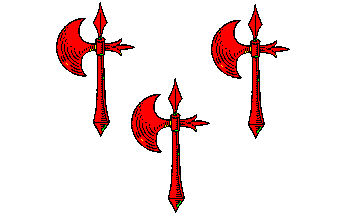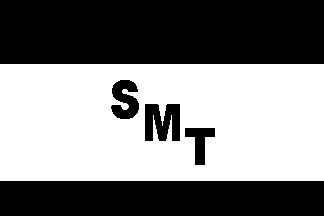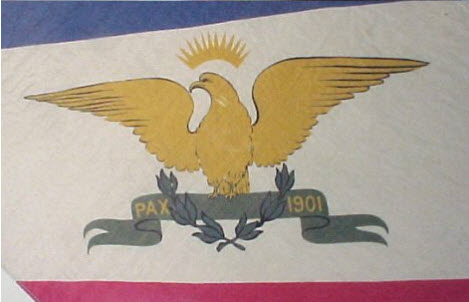
Last modified: 2014-12-27 by pete loeser
Keywords: ufe | unidentified flags |
Links: FOTW homepage |
search |
disclaimer and copyright |
write us |
mirrors
Please note our Policy for Submissions and Enquiries.
Below is a series of images of flags that have been provided to FOTW; some we have recognized, and some we have been unable to recognize. If you can help us identify any of these flags, please let us know! Contact the: UFE Editor.Identification Key:
02-1. Three Axes Flag at World Cup
![]() Some Speculation
Some Speculation
 Image from Al Kirsch
Image from Al Kirsch
During the World Cup final (2002: Brazil vs.Germany), around the 50th minute was seen on TV a white flag with three red axes. It looked more German than Brazilian. Is anyone to identify it?
Ivan Sache, 1 July 2002
The website at
http://www.mindspring.com/~debard/bardeleben.htm shows a three-axes flag
that might give a lead.
Ewald Mertins, 28 August 2002
Not sure it does; it's a reference to his family arms, and the axes there are black. What we saw was white with three red axes. Do any of the towns mentioned on the page have arms/flag like that?
Al Kirsch, 29 August 2002
Mystery solved - This is a fictious flag from the browser game of Promisance.
Valentin Poposki, 11 April 2012
To add to Vanja's comment: "Jennifer Government: NationStates is a multiplayer nation simulation
browser game. It was created by Max Barry and was publicly released on 13 November 2002, based loosely on his novel Jennifer Government. The game has hosted over 3.1 million nations with 105,000 current
players.[3] The game is expanded by users using off-site forums to construct centres of learning, discussion and play." Source: http://en.wikipedia.org/wiki/Nation_States
Thus, the three-axe flag is that of Promisance, a cybernation featured in this game. There are other cyber nation flags featured here as well:
http://www.nationstates.net/page=world (notice that some of this flags are based on real flags, like the The Empire of Corsaria flag (based on the Albania flag), among others). For additional information go to: http://www.nationstates.net/
Esteban Rivera, 11 April 2012
I'm afraid that the mystery is still with us. According to the website, NationStates was released on 13 Nov 2002 (and Promisance may not have been a charter member) yet the UFE was spotted by Al on 1 July 2002. Further, I'm pretty sure the flag graphic displayed at the Prominance page is a lifted copy of Ivan's GIF from the 2002 UFE page, not an original design by Promisance's owner. So the flag may represent Promisance now, but it is still unkown by us what it represented earlier.
Ned Smith, 11 April 2012
Ned made a good point, there is no doubt about it. But, we'll probably be stuck with this image, so I tried to figure out where geographically this symbols belongs. I decided most probably in Western Europe, but probably not Great Britain, Spain, or Portugal. I suspect France pretty much, although it might also be Belgium, Netherlands, Luxembourg or even Germany. Further, it must be
pretty obscure, so it might be a small communal flag/coat of arms, or a feudal emblem.
I found one municipal emblem which is similar - Concarneau, and again a fantasy design on similar theme. But, we have to have on mind that France has more than 40.000 communes, and additionally several thousands in the nearby countries, so it is very
possible that we'll never know the truth, but...
"The truth is out there..." ![]()
Valentin Poposki, 11 April 2012
My original report includes contextual information - sometimes, it may help. The mysterious flag was seen during the final of World Cup 2002, Brazil-Germany. The Arms of Concarneau appear on the municipal flag, but I don't expect the mysterious flag to be related with Concarneau, first because of the context, and second because of the lack of ermines, the ermines emphasizing the Breton location of Concarneau. More than "40,000 communes" is a gross exaggeration. According to INSEE, France had "only" 36,700 communes on 1 January 2012.
Ivan Sache, 12 April 2012
Ah, but have they always been in there? I sometimes get the impression there's been a lot of "erminification", from people who feel they need to express Bretonism.
What you show aren't hatchets of one type or another, BTW, but are clearly battle axes; note, for example, the sharp point opposite the blade. There are, of course, arms that do have three battle axes, but I don't think there are all that many, and the only ones I can come up with at the moment are some English noble families.
Anyway, I would take a look at the broadcast, but do you recall more than that it was approximately 5 minutes into the second half, if that's what you meant? Was this flag waved? Floating on the audience? (Hm, didn't realise before that that's also a possible way to fly a flag.) Hanging over the advertising boards?
And do you recall the kind of shot? Was this an audience shot while play was paused, or in the background of a player shot? Or a shot of play where it could just be made out? Any detail, that you're certain of, would help, as there's a lot of unnecessary shots of people who can't make up their collective mind about where the ball ought to be in those broadcasts, and they tend to drown the important stuff. Does French (?) television repeat shots, or might it have been an audience shot while other viewers saw something happen again? ![]()
Peter Hans van den Muijzenberg, 12 April 2012
It always help, in the case of UFEs. Sadly often in FotW-ws some\irrelevant or even misleading context information from the list is kept (such as "This image should replace the one we have on the page."), but not less sadly so often in UFEs irrelevant and insightful context information was stripped in editing. I should add however that AFAICT none of this stripping was done during Pete’s tenure. Concerning this image, a question for Ivan, which may or may have not been covered in his original posting: Whereas this is reported from a TV spotting and the presented image is clearly an adapted scan, its style hinting at a 19th century original source, I wonder about the story of this particular image. Was it clipped from random sources to make up the arrangement of the flag you saw, Ivan? If so, how accurate/relevant are the details of the axes? If not, what’s the story?
António MARTINS-Tuválkin 12 April 2012
Browsing this specific thread in the archives of the list, I noticed that a detail of my contribution was deleted [underline added by editor for the sake of identification]: "An unidentified flags was shown very briefly during the final, around the 50th minute. It looked square and showed three red axes on a white field. It looked more German than Brazilian. Anyone to identify it?"
Then I wondered why I had submitted a rectangular flag (oddly enough, 350 px x 216 px) while writing it was rather square. It appears that I did not contribute the aforementioned image, therefore I cannot answer your questions.
[To answer] Peter Hans van den Muijzenberg question: Ermines were introduced to Brittany in the 13th century and the arms of Concarneau, with ermines, were registered in the Armorial Général in the 17th century. While the reemergence of the Breton identity in the 1970s increased the popularity of the ermines and the emblem that show them, there was nosignificant "erminification" since the ermines were already there, just waiting being noticed.
The archives include a reply by Al Kirsch, who confirmed my sighting and added in yet another message "the axes were distinctly medieval European in design" (excluding a local, Japanese emblem). I browsed on YouTube a copy of the original broadcast by the Japanese TV, but did not notice the flag where I had seen it. This particular broadcast includes very few scenes from the stand, which seems rather unusual. I don't know if different broadcasts were released.
Ivan Sache 12 April 2012
Al made the image from some clip-art. The shape of the battle axes he used was specifically the type he saw, but the measures were unspecific. Hopefully he'll see this and answer.
I've found one YouTube movie on the Final of World Cup 2002, but I can't follow what the commentators are saying, but that's not a problem until I've found the flag and can't hear them identify it.) If you found a different one, let me know.
That's why I asked whether French TV had a habit of showing repeat shots. When play is, more or less, paused, some networks seem to show fifteen angles of the last somewhat important even of the match. In the mean time, however, the cameras are still sending images, and other networks choose (if they have a choice) to broadcast those images instead, which usually give an impression of the stadium, with shots of part of the audience.
Was it indeed such an audience shot you saw the flag in? If so, do you nevertheless have an idea of where in the stadium this would have been? And from trying to see it again, have you been able to make a good estimate of when in the match it was, or is approximately five minutes past the break, if that's what you meant, the best we have?
Peter Hans van den Muijzenberg, 12 April 2012

This flag has been identified as that of the English Premier Football League and is now on its proper page.
Lately I've noticed a black - medium blue - black, arranged horizontally auto tag on many vehicles in the area around Pittsburgh, Pennsylvania. Anyone know what this means?
John Evosevic, 3 July 2002
The Black-Blue-Black design is usually seen on a policeman's personal car or family members car. It stands for the "thin blue line". There is also a similar one with a red strip for firemen.
Jim Popovitch, 17 August 2002
The black-medium blue-black flag is actually a police mourning band. It is typically worn as a band across the badge when an officer is killed in the line of duty. I have seen it in use more frequently now as a bumper sticker, I believe this is probably a show of respect for the police officers killed on September 11th.
Troy Corwin, 26 September 2002
This design is an identification to notify other law enforcementpeople that the bearer also works in law enforcement. It representsthe "thin blue line, or brother police officer. The identification of fallen officers uses a badge with black tape or a black elastic band around the center. It is usually only worn when an officer dies, and is worn for up to a week after death, not everyday use.
Bob Cunningham II, 8 May 2006
Although this flag already has a positive identification. it is interesting that the British shipping company James Hall, located in Sunderland, had the same black over blue over black horizontal triband. Source: Lloyds flags and funnels, ed. 1912, p.81, image no.925.
Klaus-Michael Schneider, 9 February 2009
This flag is described as the flag of Singapore in the Polish Yearbook Swiat w Przekroju from 1960/61. I haven't seen it before.
O. Myszor, 20 May 2002
02-5. German Tank Flag
![]() Positive ID
Positive ID
![[German tank flag]](../images/d/de_ufe.jpg) Image sent by Mary Oldring
Image sent by Mary Oldring
Maybe you can help me. I don't know what this is called. This flag was removed from a German Tank in Holland during World War II. Any information you might have would be gratefully appreciated.
Mary Oldring, 11 Oct 2002
I believe that the yellow flag with a blue cross found on a German tank is Swedish. Soldiers from Sweden were fighting on both sides in World War II, so the crew on that tank probably was from Sweden. I have seen that flag as an alternative flag in Sweden before.
Ted Nordin, 24 Aug 2007
This is a pre-World War II German aircraft identification flag, based upon the Nationalist insignia of the Spanish Civil War. It was used by ground units to help friendly aircraft identify vehicles readily from the air. Designed to be stretched over a flat area of the vehicle that faced upwards. It was used in much the same manner as the "^" insignia was used by coalition forces in the Gulf War to prevent friendly units from being mistaken for the enemy.
Ken Bassford, 15 Oct 2009
 Image discovered by Alexander Manannikov, 16 August 2012
Image discovered by Alexander Manannikov, 16 August 2012
I think I can help you identify this flag, similar flags are shown at http://www.network54.com/Forum/637977/thread/1302265442/Ausfallflagge.
Alexander Manannikov, 16 August 2012
[Editorial Comment: A summary translation of the document Alexander discovered listed several similar flags, called Führungszeichen, that German Tiger companies used for communications. For example, one flag (white/red/black) with a cross was used to give commands on the move to change formations and actions to be taken (meet, attack, wedge, etc.). A yellow flag with a black cross appeared to be a danger flag (warning for mines, enemy antitank gun, tank out of action, or needing help). However, the text doesn't specifically mention a yellow flag with a blue cross.]

This flag was identified and now can be found on its proper page at German Vehicle Recognition Drapes (World War II).
02-7. Upside down "Y" Flag
![]() Positive ID
Positive ID

This has been identified as the Ku Klux Klan, LLC Flag and is now on the KKK page.
02-8. Walkyrie Flag
![]() Tentative ID
Tentative ID
 Image by Jaume Ollé, 05 Jun 2000
Image by Jaume Ollé, 05 Jun 2000
Nazi group Walkyrie (I don’t know what country); source: communication from José Luís Cepero.
Jaume Ollé, 5 June 2000
This may be a current flag used by the Golden Dawn Movement in Greece. (Other groups use similar ones.)
Rick Prohaska, 30 January 2010
Good point: They do use a cross with a circle: Golden Dawn (Political organization, Greece). The snag is that the Golden Dawn Movement always uses a very Celtic-like Cross, so this may indeed be another group using it.
Peter Hans van den Muijzenberg, January 30, 2010
02-9. Unknown Nazi German Eagle Flag
![]() Positive ID
Positive ID
This flag has been identified as a Deutscher Schützenbund, or German Rifle Club flag of the Third Reich.
 Image by Bill Sullivan, 27 Nov 2000
Image by Bill Sullivan, 27 Nov 2000
This unknown house flag(?) was submitted without country, location, or origin. Does anybody recognize it?
Bill Sullivan, 27 Nov 2000
Well, the only SMT with cascading lettering I managed to find were "Society for Sales & Marketing Training". Maybe if you asked them?
Peter Hans van den Muijzenberg, 12 February 2012

 Detail of emblem
Detail of emblem
Images from Bill Garrison, 3 June 2002
We are really not sure of just what this flag represents, but we believe that it is a Spanish American War Era Regimental Flag. It measures approx. 21" x 12" and pictures an Eagle in the central panel perched on a Army green ribbon which reads "Pax 1901". The left hand panel depicts a single white star on a blue field and the right hand panel has 4 white stars on a red field. The flag was sold to us as a Pan-American Exposition Flag, but it sure looks a lot more like a regimental flag to us. If anyone can help with any information regarding this flag please email us and we will pass it along. The flag is of medium weight flag linen material and is in excellent condition with the only damage being a very small tear on the neck of the eagle - the colors are bright and the flag is VERY attractive. It looks as if it was recently mounted in a modern wood frame for display. Simply a beautiful c1900 flag and we believe it may possibly be a very important military regimental piece.
Bill Garrison, 3 June 2002